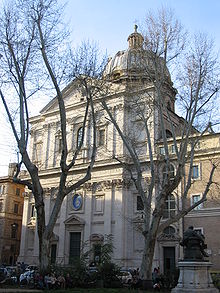This article includes a list of general references, but it lacks sufficient corresponding inline citations. (July 2016) |
| San Carlo ai Catinari | |
|---|---|
Chiesa di Santi Biagio e Carlo ai Catinari | |
 Facade | |
 Click on the map for a fullscreen view | |
| 41°53′39.1″N 12°28′30.9″E / 41.894194°N 12.475250°E | |
| Location | Piazza Benedetto Cairoli, Rome |
| Country | Italy |
| Denomination | Roman Catholic |
| Tradition | Roman Rite |
| Religious institute | Barnabites |
| History | |
| Status | Titular church |
| Dedication | Saint Blaise and Saint Charles Borromeo |
| Relics held | Saint Blaise (neck vertebrae) |
| Architecture | |
| Architect(s) | Rosato Rosati, Giovanni Battista Soria |
| Architectural type | Church |
| Completed | 1638 |
| Administration | |
| Province | Diocese of Rome |
San Carlo ai Catinari, also called Santi Biagio e Carlo ai Catinari ("Saints Blaise and Charles at the Bowl-Makers"), is an early-Baroque style church in Rome, Italy. It is located on Piazza Benedetto Cairoli, 117 just off the corner of Via Arenula and Via dei Falegnami, a few blocks south of the church of Sant'Andrea della Valle.
The attribute ai Catinari refers to the presence, at the time of its construction, of the many makers of wooden basins (Italian catini) who worked in the area.[1][2][3] The church was commissioned by the Order of the Barnabites and funded by the Milanese community in Rome to honour their fellow Milanese St. Charles Borromeo (Italian: San Carlo). It is one of at least three Roman churches dedicated to him (including San Carlo al Corso and San Carlo alle Quattro Fontane) and one of a number of great 17th century preaching churches built by Counter-Reformation orders in the Centro Storico (the others being The Gesù and Sant'Ignazio of the Jesuits, Sant'Andrea della Valle of the Theatines, and the Chiesa Nuova of the Oratorians).
- ^ Inc, DK Publishing; Ercoli, Olivia; Mitchell, Roberta; Belford, Ros (April 8, 2006). Rome. DK Pub. ISBN 9780756615505 – via Google Books.
{{cite book}}:|last1=has generic name (help) - ^ Dixon, Susan M. (August 11, 2008). Italian Baroque Art. Wiley. ISBN 9781405139670 – via Google Books.
- ^ Jones, PamelaM (July 5, 2017). Altarpieces and Their Viewers in the Churches of Rome from Caravaggio to Guido Reni. Routledge. ISBN 9781351576970 – via Google Books.